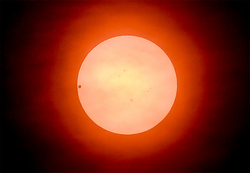 Legendary Pulkovo Observatory intends to revive the service of the Sun. Russian solar patrol will consist of 8 telescopes, placed along the meridians so that was rising was in the field of view of researchers. Legendary Pulkovo Observatory intends to revive the service of the Sun. Russian solar patrol will consist of 8 telescopes, placed along the meridians so that was rising was in the field of view of researchers.
As said the head of Department of physics of the Sun, the chief Deputy Director of the Pulkovo astronomical Observatory (GAO RAS) Yuri Nagovitsyn, this will allow to predict solar flares that can affect power grids, pipelines, computer and aviation equipment and people's health.
The experimental pattern and the 1st instance of the series have already been made and work at Kislovodsk astronomical station of the Pulkovo Observatory. "1-s 2 telescope made modern Kulibina running of the station master Andrew Tlatov. The following instances will be made in cooperation between experienced the creation of the Pulkovo Observatory and colleagues in Novosibirsk and will be completely identical to each other in the technical data quoted Nagovitsyn ITAR-TASS.
Creating a service is estimated at 50 million. Evidence of Federal funding yet, at the Observatory does not preclude the receipt of funds from extrabudgetary sources.
Data center service Sun will come at Pulkovo Observatory. Telescopes will be fully automatic, monitor their work, scientists will be able in real time. In addition to already working in Kislovodsk apparatus identical telescopes set in Pulkovo, Crimean (in the village of Science), Kourovka (included in the system Ekaterinburg Institute) observatories, 2 of the apparatus will be in the Irkutsk region (Observatory of Irkutsk Institute and Observatory of the Institute of solar-terrestrial physics in Mondy), in Ussuriysk (in Astrophysical Observatory of the far Eastern branch of Russian Academy of Sciences) and in Cuba.
Taking into account the opinion Nagovitsyn, the service is able to earn in the full format after only 2 years. Note that solar flares can affect people and equipment. Its rotation with a speed of 13 degrees per day allows the patrol to warn service for a couple of days about the possibility of solar flares.
sections: Society
|